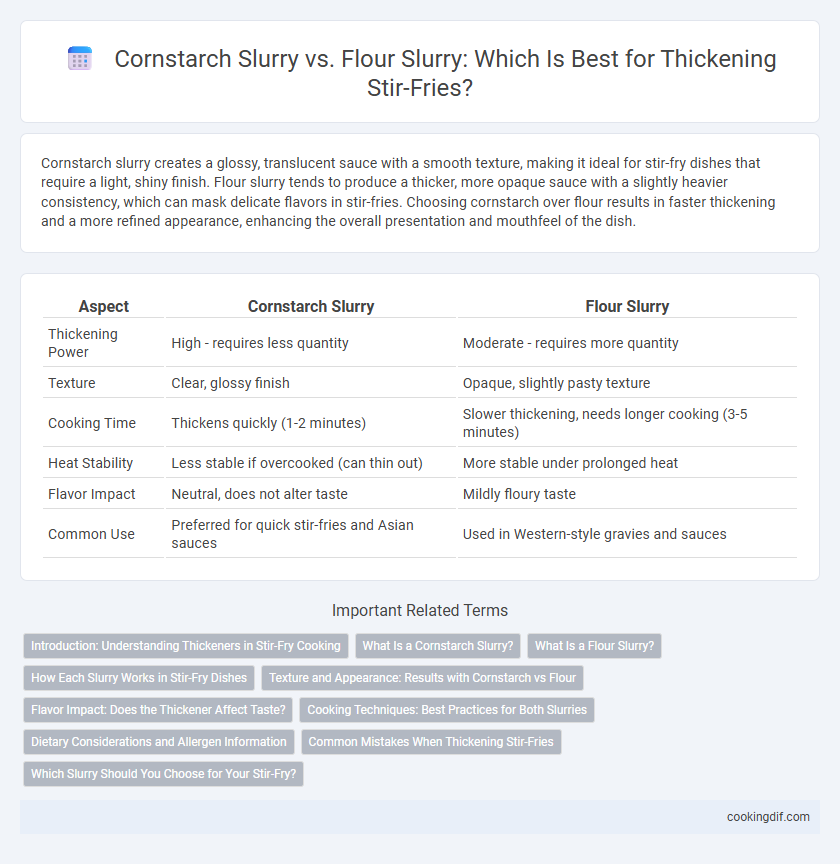Cornstarch slurry creates a glossy, translucent sauce with a smooth texture, making it ideal for stir-fry dishes that require a light, shiny finish. Flour slurry tends to produce a thicker, more opaque sauce with a slightly heavier consistency, which can mask delicate flavors in stir-fries. Choosing cornstarch over flour results in faster thickening and a more refined appearance, enhancing the overall presentation and mouthfeel of the dish.
Table of Comparison
| Aspect | Cornstarch Slurry | Flour Slurry |
|---|---|---|
| Thickening Power | High - requires less quantity | Moderate - requires more quantity |
| Texture | Clear, glossy finish | Opaque, slightly pasty texture |
| Cooking Time | Thickens quickly (1-2 minutes) | Slower thickening, needs longer cooking (3-5 minutes) |
| Heat Stability | Less stable if overcooked (can thin out) | More stable under prolonged heat |
| Flavor Impact | Neutral, does not alter taste | Mildly floury taste |
| Common Use | Preferred for quick stir-fries and Asian sauces | Used in Western-style gravies and sauces |
Introduction: Understanding Thickeners in Stir-Fry Cooking
Cornstarch slurry, made by mixing cornstarch with cold water, creates a glossy, translucent finish and thickens sauces quickly at low heat, making it ideal for stir-fry dishes. Flour slurry, combining all-purpose flour with water, requires longer cooking times to remove its raw taste and produces a more opaque, less glossy sauce. Understanding these differences helps cooks achieve the desired sauce texture and appearance in stir-fry recipes.
What Is a Cornstarch Slurry?
A cornstarch slurry is a mixture of cornstarch and cold water used as a thickening agent in stir-fry sauces, providing a glossy and smooth texture. It thickens sauces quickly at high heat and creates a clear, transparent finish, unlike flour slurry which can result in a cloudy or dull appearance. Cornstarch slurry is preferred in stir-fry dishes for its ability to enhance sauce consistency without altering flavor.
What Is a Flour Slurry?
A flour slurry is a mixture of all-purpose flour and cold water used as a thickening agent in stir-fry sauces. It creates a slightly opaque, smooth texture while providing a more substantial, less glossy finish compared to a cornstarch slurry. Flour slurries require longer cooking times to eliminate raw flour taste and achieve optimal thickening.
How Each Slurry Works in Stir-Fry Dishes
Cornstarch slurry thickens stir-fry sauces quickly by gelatinizing under high heat, creating a glossy, translucent finish that clings well to vegetables and meats. Flour slurry requires longer cooking to eliminate its raw taste and produces a more opaque, matte sauce with a slightly heavier texture. Understanding these differences helps achieve desired sauce consistency and appearance in stir-fry dishes.
Texture and Appearance: Results with Cornstarch vs Flour
Cornstarch slurry yields a glossy, translucent finish and creates a smooth, silky texture when used as a thickener in stir-fry sauces. Flour slurry produces a more opaque, matte appearance and results in a thicker, slightly grainier texture. Cornstarch thickens more quickly at lower temperatures, enhancing the visual appeal and mouthfeel compared to the heavier, denser consistency from flour.
Flavor Impact: Does the Thickener Affect Taste?
Cornstarch slurry creates a glossy, smooth texture without altering the flavor of a stir-fry, making it ideal for dishes that require a clean, vibrant taste. Flour slurry imparts a slightly nutty, richer flavor due to the presence of bran and proteins, which can add depth but may mask subtle ingredients. Choosing between cornstarch and flour slurries depends on whether the goal is to maintain flavor neutrality or introduce a mild, toasted note in the sauce.
Cooking Techniques: Best Practices for Both Slurries
Cornstarch slurry, made by mixing cornstarch with cold water, provides a glossy, translucent finish and thickens sauces quickly at lower temperatures, making it ideal for delicate stir-fry dishes. Flour slurry, composed of flour and water, requires longer cooking to eliminate its raw taste and produces a cloudier, more opaque sauce with a slightly heavier texture, suitable for rustic or heartier stir-fries. For best results, add cornstarch slurry near the end of cooking to avoid over-thickening, while flour slurry should be incorporated earlier to allow sufficient cooking and even thickening.
Dietary Considerations and Allergen Information
Cornstarch slurry is gluten-free and ideal for individuals with gluten intolerance or celiac disease, providing a clear, glossy finish to stir-fry sauces. Flour slurry contains gluten and may trigger allergic reactions or sensitivities, making it less suitable for those with wheat allergies. Choosing cornstarch supports a wider range of dietary restrictions while maintaining effective thickening properties.
Common Mistakes When Thickening Stir-Fries
Using too much cornstarch slurry can result in a gluey texture, while insufficient stirring causes uneven thickening in stir-fries. Flour slurry often leads to a cloudy sauce and may require longer cooking to remove the raw flour taste. Overheating cornstarch slurry breaks down the thickening power, so precise temperature control is essential for a glossy, smooth stir-fry sauce.
Which Slurry Should You Choose for Your Stir-Fry?
Cornstarch slurry creates a glossy, translucent sauce and thickens quickly, making it ideal for stir-fries requiring a light, smooth texture. Flour slurry produces a more opaque, matte finish with a slightly denser consistency, better suited for heartier, rustic dishes. For authentic Asian-style stir-fries, cornstarch slurry is typically preferred due to its neutral flavor and superior thickening power.
Cornstarch slurry vs Flour slurry for thickening Infographic

 cookingdif.com
cookingdif.com